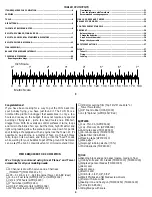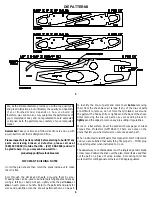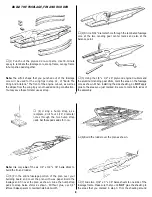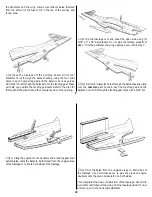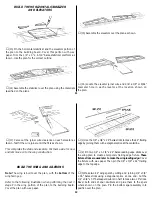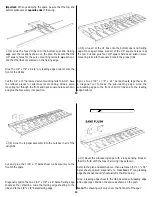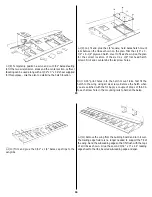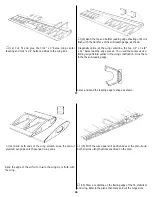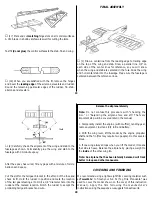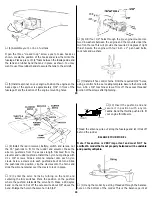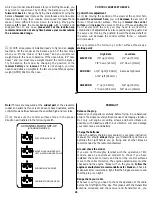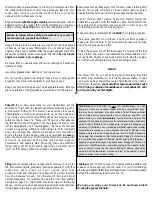
should be able to walk at least 100 feet [30.5 meters] away from
the model and still have control. Have someone stand by your
model and, while you work the controls, tell you what the
various control surfaces are doing.
Repeat this test with the engine running at various speeds, with an
assistant holding the model. If the control surfaces are not always
acting correctly, do not fly! Find and correct the problem first.
Keep all engine fuel in a safe place, away from high heat, sparks
or flames, as fuel is very flammable. Do not smoke near the
engine or fuel; and remember that the engine exhaust gives off a
great deal of deadly carbon monoxide. Therefore do not run the
engine in a closed room or garage.
Get help from an experienced pilot when learning to adjust and
operate engines.
Use safety glasses when starting or running engines.
Do not run the engine in an area of loose gravel or sand, as the
propeller may throw such material in your face or eyes.
Keep your face and body as well as all spectators away from the
plane of rotation of the propeller as you start and run the engine.
Keep items such as these away from the prop: loose clothing, shirt
sleeves, ties, scarfs, long hair or loose objects (pencils, screw
drivers) that may fall out of shirt or jacket pockets into the prop.
Use a “chicken stick” device or electric starter; follow the
instructions supplied with the starter or stick. Make certain the
glow plug clip or connector is secure so that it will not pop off
or otherwise get into the running propeller.
Make all engine adjustments from behind the rotating propeller.
The engine gets hot! Do not touch it during or after operation.
Make sure fuel lines are in good condition so fuel will not leak
onto a hot engine causing a fire.
To stop the engine, cut off the fuel supply by closing off the fuel
line or follow the engine manufacturer’s recommendations. Do
not use hands, fingers or any body part to try to stop the engine.
Do not throw anything into the prop of a running engine.
FLIGHT
The Tower Fun 51 is a great flying sport airplane that flies
smoothly and predictably, yet is highly maneuverable. It does
not, however, have the self-recovery characteristics of a primary
R/C trainer; therefore,
you must either have mastered the basics
of R/C flying or obtained the assistance of a competent R/C pilot
to help you with your first flights.
Failure to follow these safety precautions may result in
severe injury to yourself and others.
27
Takeoff: If you have dual rates on your transmitter, set the
switches to “high rate” for takeoff, especially when taking off in
a crosswind. Although this model has excellent low speed
characteristics, you should always build up as much speed as
your runway will permit before lifting off, as this will give you a
safety margin in case of a “flame-out.” When you first advance
the throttle and the tail begins to lift, the plane will start to turn
left (a characteristic of all “tail draggers”). Be ready for this and
correct by applying sufficient right rudder to hold it straight
down the runway. The left-turning tendency will diminish as
soon as the tail is up and the plane picks up speed. Be sure to
allow the tail to come up. Don’t hold the tail on the ground with
too much up elevator, as the plane will become airborne
prematurely and possibly stall. When the plane has sufficient
flying speed, lift off by smoothly applying up elevator (don’t
“jerk” it off to a steep climb!) and climb out gradually.
Flying: We recommend that you take it easy with your Fun 51 for
the first several flights, gradually “getting acquainted” with this
responsive sport plane as your engine gets fully
broken-in. Add and practice one maneuver at a time, learning
how she behaves in each. For ultra-smooth flying and most
normal maneuvers, we recommend using the “low rate” settings
as listed on page 25. “High rates” should be used for tearing up
the sky, low level loops, snaps and spins and most quick response
flying. Speed is the key to good knife-edge performance.
Landing: When it’s time to land, fly a normal landing pattern and
make your final approach into the wind. For your first landings,
plan to land slightly faster than stall speed and on all three wheels,
as this is the easiest way to land your Fun 51.
We hope you enjoy your Tower Fun 51 and have a blast
wowing the guys at the field.
CAUTION (THIS APPLIES TO ALL R/C AIRPLANES): If, while
flying, you notice any unusual sounds, such as a low-pitched “buzz,”
this may be an indication of control surface “flutter.” Because flutter
can quickly destroy components of your airplane, any time you
detect flutter you must immediately cut the throttle and land the
airplane! Check all servo grommets for deterioration (this will indicate
which surface fluttered), and make sure all pushrod linkages are
slop-free. If it fluttered once, it probably will flutter again under similar
circumstances unless you can eliminate the slop or flexing in the
linkages. Here are some things which can result in flutter: Excessive
hinge gap; Not mounting control horns solidly; Sloppy fit of clevis pin
in horn; Elasticity present in flexible plastic pushrods; Side-play of
pushrod in guide tube caused by tight bends; Sloppy fit of Z-bend in
servo arm; Insufficient glue used when gluing in the elevator joiner
wire or aileron torque rod; Excessive flexing of aileron, caused by
using too soft balsa aileron; Excessive “play” or “backlash” in servo
gears; and Insecure servo mounting.


